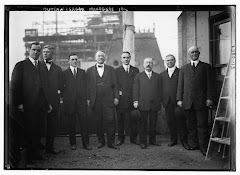Rating: 4 glorious homemade pierogies (almost good enough to be 5, but not quite)
Review: I had never heard about this book before, and then three separate people recommended The Devil in the White City to me in the space of two days. I needed to see what I was missing.

Larson tirelessly researched turn-of-the-century Chicago, in this nonfiction work that simultaneously explores the path to the creation of the 1893 Chicago World's Fair, as well as traces the mystery of a serial killer, H. H. Holmes, feeding on the crowds the fair attracts. This book reads like fiction and is very engaging. I appreciate that Larson included endnotes, with an epilogue inviting the reader to personally explore the sources.
Larson alternates skilfully between the two storylines, it never feels choppy or uneven. Larson took great pains to give the reader the true feel of Holmes' personality. Holmes' most distinctive and disturbing traits were his chilling blue eyes and cool demeanor. The description the first few times around was effective. However, Larson repeats this description every time Holmes makes a new acquaintance, and after a while it is tiresome. Although this is a serial killer book, it's not frightening. Actually, I found the storyline about the construction of the fair, the tight deadlines, and its looming failure to be very stressful, and create much more of an impression.

Larson explained how he used Truman Capote's In Cold Blood as an inspiration for his work. In Cold Blood is one of my favorite books. Devil in the White City can't stand up to the poetry of Capote's language or the atmosphere Capote creates, but if you're a fan of In Cold Blood, you will likely find this book enjoyable.
During and after reading Devil in the White City, I've been thinking about the condition of America at the time of the World's Fair. A fair like this simply could never happen again. Oh, we could easily put on an enormous exposition, however, the world was a much larger place (so to speak) then. We are no longer small town bumpkins who revel in wonder at cowboys or bellydancers. Between National Geographic and the internet, we have access to everything. There is nothing left to revel at anymore.

No comments:
Post a Comment